Life is beautiful at Moroccan-inspired Tanglewild Gardens
As we roll toward summer here in Austin, this gardener begins to fantasize about decamping for cooler climes, like the Pacific Northwest, a gardener’s paradise. So it was surprising and enlightening to hear Skottie O’Mahony and Jeff Breitenstein, longtime Seattle residents who are now cultivating an exotic, ambitious garden in North Austin, explain why they moved to Central Texas six years ago:
“We needed to move to a warmer and less rainy climate,” they said, and Austin’s long, hot summer (combined with regular watering) jump-starts their tropical-esque garden each spring, encouraging early, lush growth. The couple also hybridizes daylilies — they’re currently growing more than 1,000 cultivars — and they can establish new plants from seed much faster here than in Seattle. So there you go — sometimes the Death Star can be your friend!
When I visited Tanglewild Gardens last weekend with a couple of friends, Skottie and Jeff hospitably invited us into their home, a 1971 split-level that they’ve transformed inside and out with Moroccan-influenced furnishings and decor, and out through the back door onto an expansive, comfortably furnished porch.
White stucco walls and black trim, a tiled roof, and oversized Moroccan lanterns create an exotic mood, even under cloudy skies threatening rain. The porch roof is clad in old cedar boards that Jeff and Skottie repurposed when they tore out an existing fence to build their garden walls. They used the fence boards on their living room ceiling as well, to wonderful effect — and as Skottie pointed out, less waste went into the landfill.
The swimming pool and back porch came with the house, but the white stuccoed walls are their addition, for Moroccan-style enclosure and privacy and to create distinct garden rooms.
String lights traverse the courtyard for evening enjoyment of the garden. Windows in the walls that extend outward from the house are inset with Moroccan-inspired, laser-cut metal panels, allowing air flow and a hint of the gardens beyond.
Antique doors in the walls create beautiful focal points and invite you to explore the rest of the garden. A mirror at the far end of the pool cleverly creates the illusion of another doorway.
Vernonia flower. Skottie says that in Seattle, when you drop something on the ground it grows, but in Texas you’re lucky if half of what you plant survives. Gardening here has been a learning curve, he admits.
Two enormous Texas mountain laurels (Sophora secundiflora), native trees with wisteria-like flowers in spring, were here when they bought the house. Not realizing what they were, they almost cut them down until an arborist convinced them otherwise. The ghost lanterns are Halloween decorations that Jeff liked so much he decided to leave them out year-round.
A tiki bar in the pool courtyard is adorned with a flowering desert rose (Adenium obesum) and, in the smaller pot, a Texas touch — ball moss, our native tillandsia.
More desert roses adorn a tray table next to an intricately carved teak doorway.
Let’s step through…
…into the Moon Garden, which is filled with pale-leaved and fragrant, white-flowering plants for evening enjoyment.
A tall, black-painted fence lets the pale plants shine. Tall, shaggy-trunked palms add height and structure, and a tiered fountain anchors a sitting area with benches.
A white-flowering vitex and moonshine-yellow cannas glow in low light.
Three carved figures — Thai rice goddesses — adorn the rear fence.
Beautiful artwork
Another Moroccan doorway beckons here. They had the walls constructed to fit the wooden doorways they’d collected from antique dealers.
Looking back toward the rice goddess figures
Moving on, this part of the garden, just below the pool courtyard, is densely shaded by live oaks, and tropical-looking rice paper plant (Tetrapanax papyrifer) grows abundantly.
Looking back up toward the pool courtyard
Heading away from the house, you come to their daylily breeding beds, all carefully labeled in raised wooden planters. A garage and shed, which the couple transformed with Thai-style accents like carved wooden panels, tiled roofs, and cedar-board skirting, enclose the space.
More daylily beds plus a cedar-skirted greenhouse
Inside the greenhouse grow flats of coleus cuttings, which they plan to plant once the daylilies are done, to fill the gaps with foliage color.
Walking to the back of their lot, an area they planted just last year, you get the feeling that the garden is even larger than its 1.7 acres. Water is abundant. They have a well, a spring, and a stretch of Tar Branch Creek (visible at lower-right), which sold them on the property. Eager for more gardening space, they left behind a tiny garden in Seattle, a plot the size of their current swimming pool area.
Another porch is visible off the back of the garage.
An upside-down tree, seeming to scuttle like Thing in the Addams Family, makes a sculptural focal point for the far end of the garden. Jeff explained that the tiny iron star affixed to it denotes a special tree in their garden and is one of five they’ve given a badge of honor. When I pointed out that they’ve adopted the Texas state symbol like natives, he laughingly said they were glad to have Texas stars now, to keep up with their Vancouver friends who adorn their gardens with Canadian maple leaves.
Here’s a surprising sight in their garden, one that they inherited with the property: a sword poking right through an old tree! Texcalibur, they’ve dubbed it. It looks as if it was placed years ago in a crotch of the tree or hacked into its trunk, and the tree grew around it, sealing it inside its widening trunk. Or is it a trick, I wondered, with two halves of a sword stuck on either side of a limb to look like it goes through?
Curious to know more, I searched online later to see if anyone had written about a sword in a tree in North Austin and found an article by Mike Cox, complete with a legend about Spanish explorers and hidden gold. In the 2011 article, an unidentified Austinite in his 70s is quoted as saying he saw what looked like an old Spanish sword in a tree near Walnut Creek in the late 1940s, when he was in the 7th or 8th grade. There’s also a Reddit thread that mentions rumors of a sword in a tree, although no one seemed to know exactly where it was.
And now Skottie and Jeff have lucked onto it. Putting aside the improbability that it’s actually a Spanish sword from the 1700s, it’s still got to be pretty old if it was already embedded in the tree back in the 1940s. When I shared the legend with Skottie, he said, “That is wild about the sword tale. Don’t I wish there was gold back there. Mostly what we find while digging is burnt foil and glass. I think the sword points to the former owner’s garbage burning area.” So much for legends, but still, what an interesting thing to find on your property. And imagine the tall tales you could spin yourself!
The real treasure to be found here, of course, is the garden that Jeff and Skottie are making, an exotic eden that evokes Morocco and Thailand with a Texas twist.
Vita pulchra est, Latin for Life is beautiful, is spelled out on their garden shed, and indeed it is. Thanks for the tour, Skottie and Jeff!
Local readers, if you’d like to see their garden yourself, you can this weekend. Tanglewild Gardens is one of four gardens on the Austin Daylily Society’s free tour this Sunday, May 28, from 10 am to 2 pm. You might also like to follow the Facebook page for Tanglewild Gardens.
I welcome your comments; please scroll to the end of this post to leave one. If you’re reading this in a subscription email, click here to visit Digging and find the comment box at the end of each post.
_______________________
Digging Deeper: News and Upcoming Events
The Austin Daylily Society will host a free garden tour on Sunday, May 28, from 10 am to 2 pm. Four private gardens featuring lots of daylilies will be open to the public, including Tanglewild Gardens and Tom Ellison’s lovely Tarrytown garden.
Calling all pond lovers! The Austin Pond & Garden Tour is coming up June 3rd (North Austin ponds and night pond) and 4th (South Austin ponds). Tickets, which are $20, can be purchased online and include entry to all 20 ponds.
Get on the mailing list for Garden Spark Talks. Inspired by the idea of house concerts, I’m hosting a series of garden talks by talented designers and authors out of my home. Talks are limited-attendance events and generally sell out within just a few days, so join the Garden Spark email list for early notifications. Simply click this link and ask to be added.
All material © 2006-2017 by Pam Penick for Digging. Unauthorized reproduction prohibited.


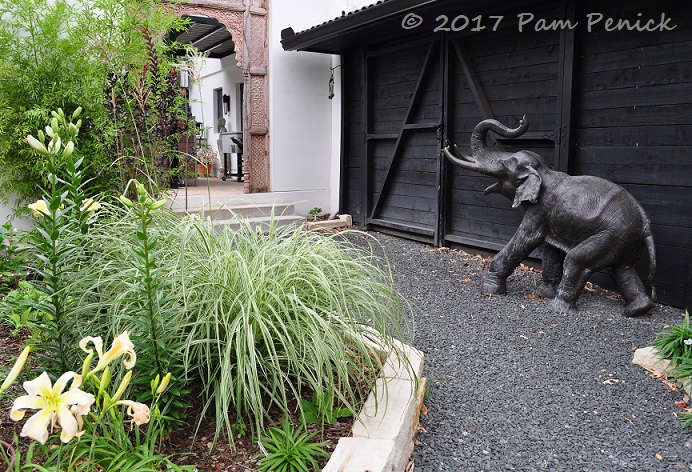
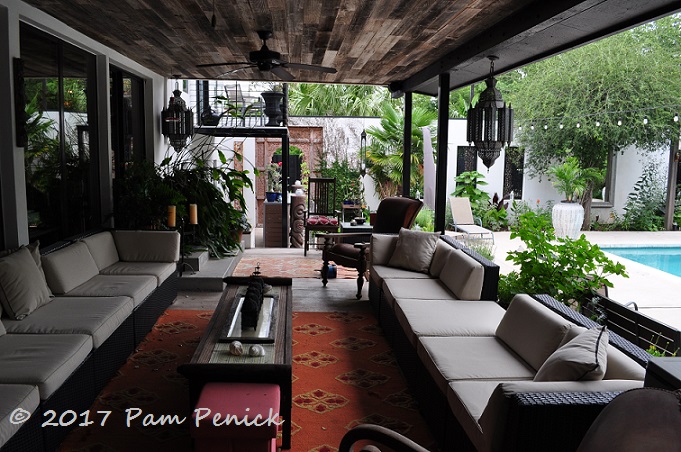
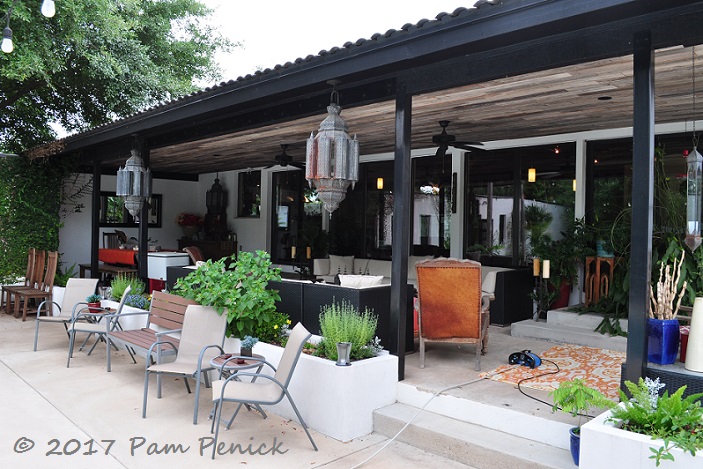
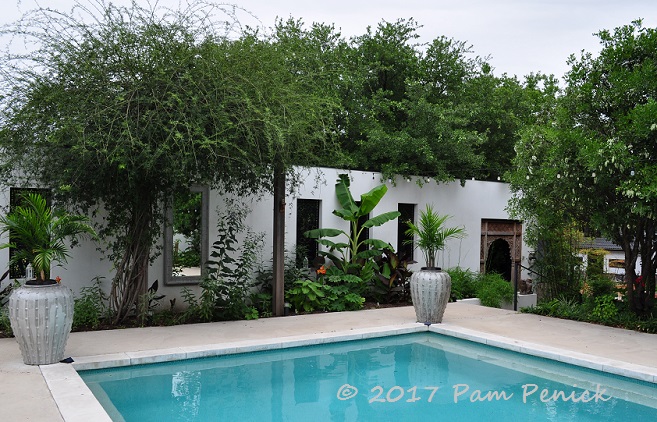
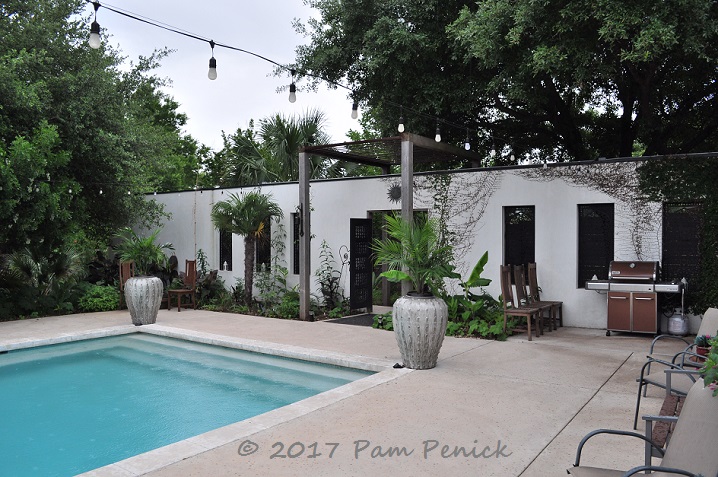
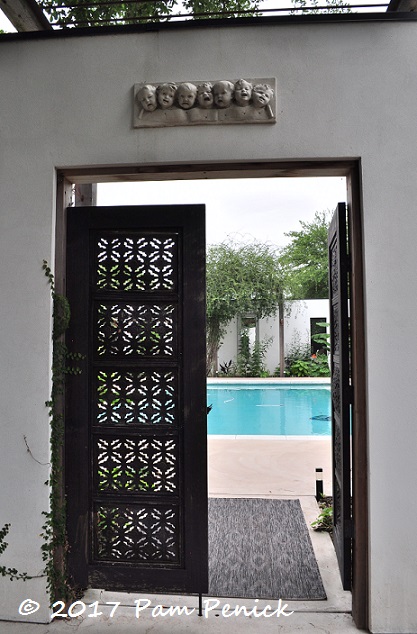
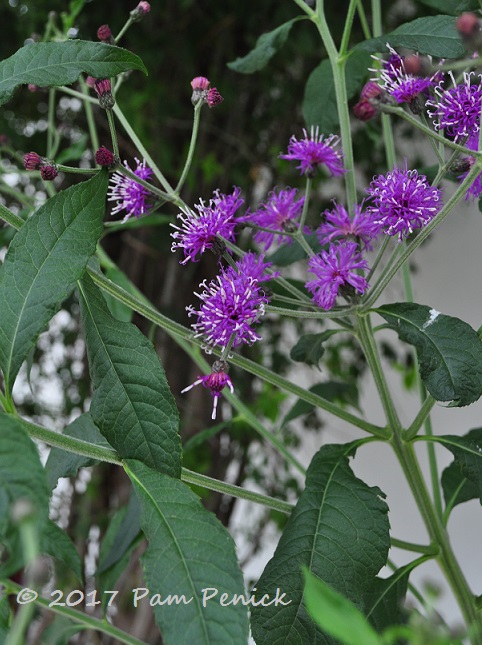
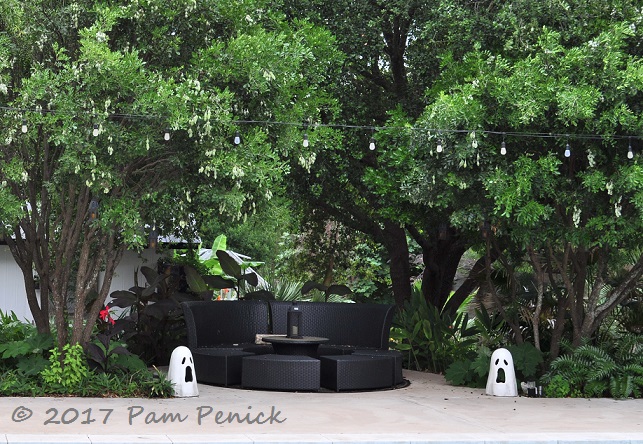
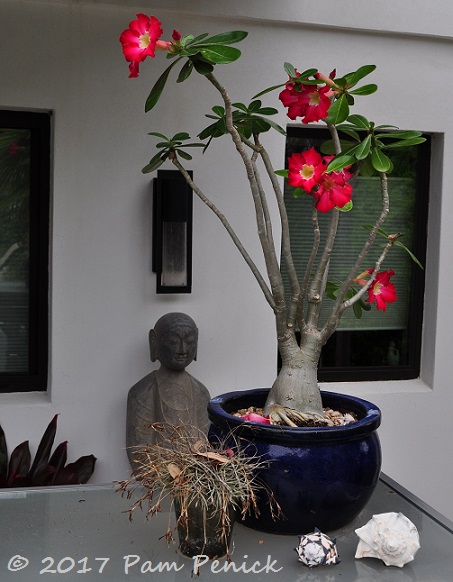
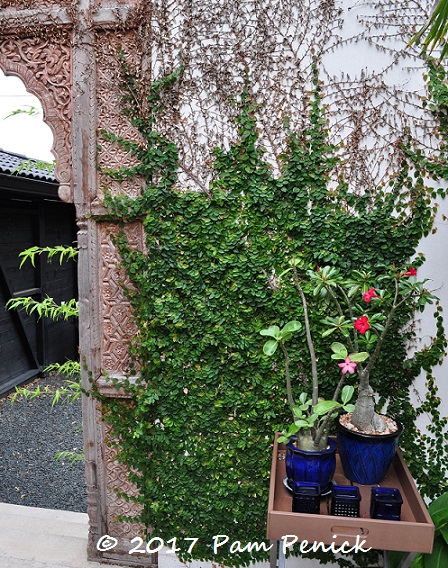
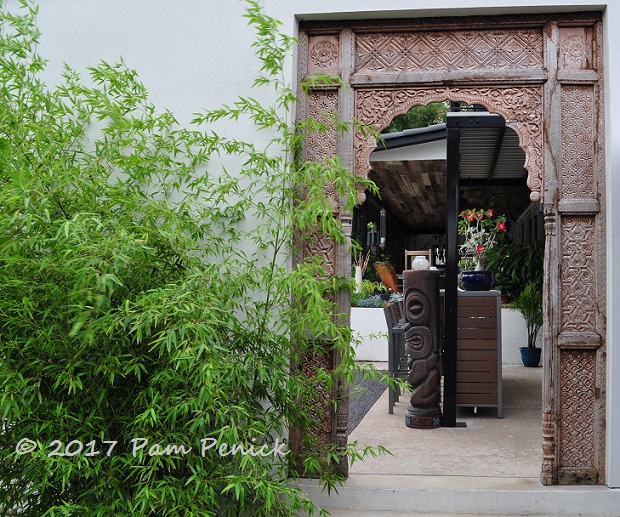
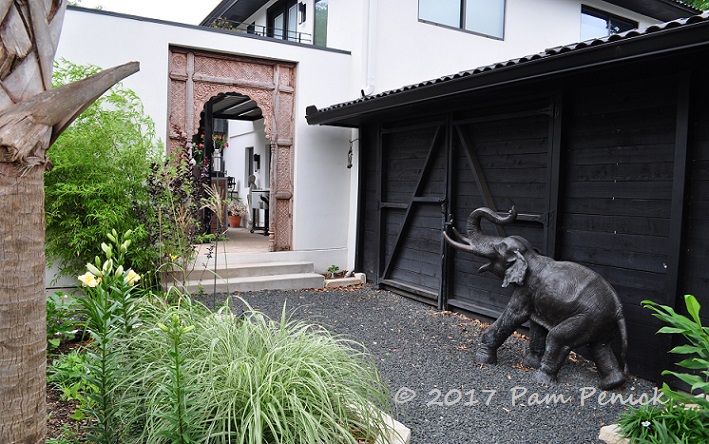
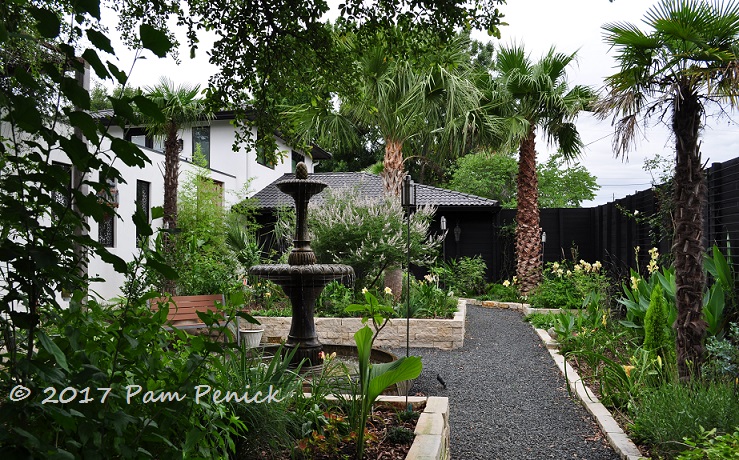
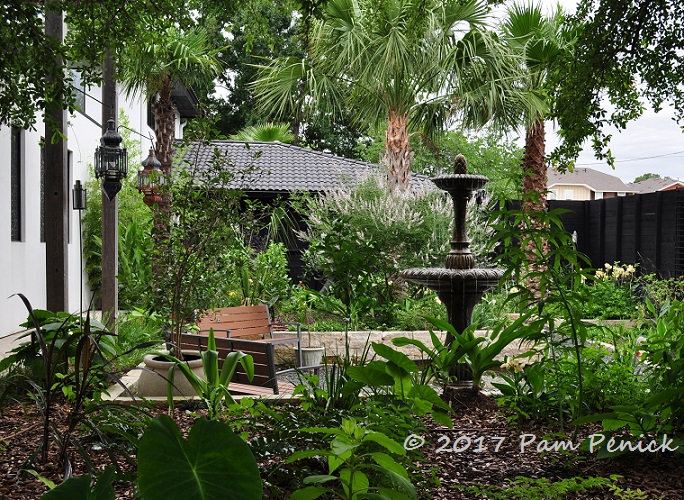
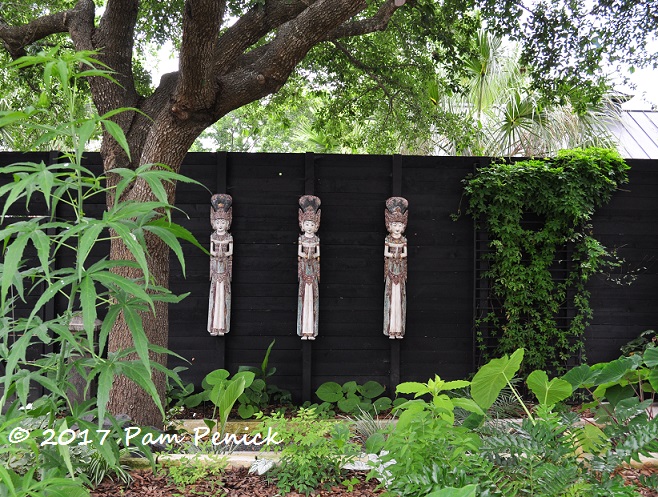
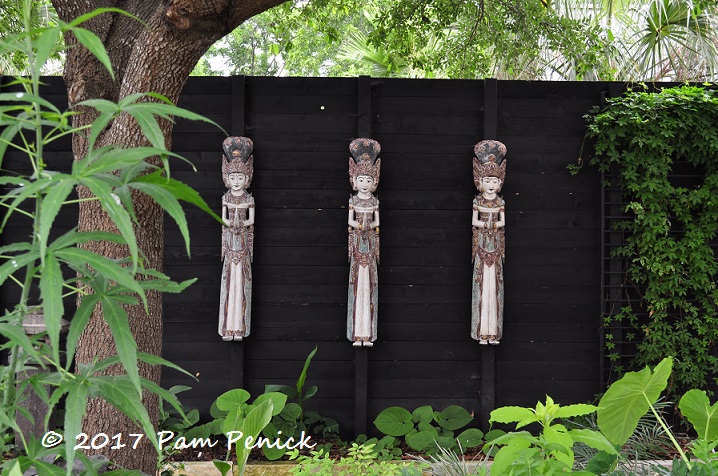
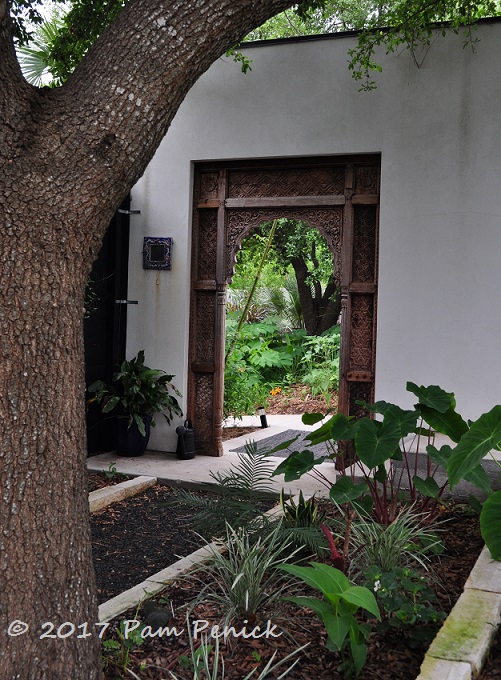
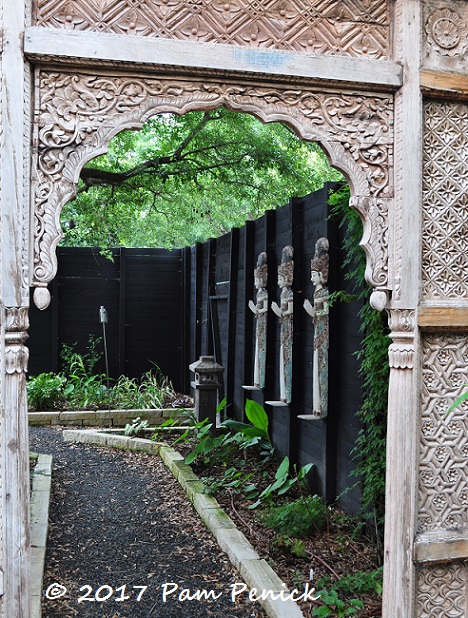
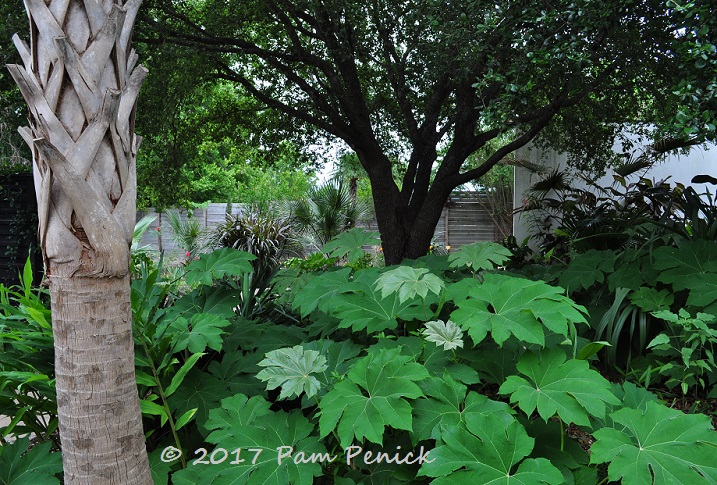
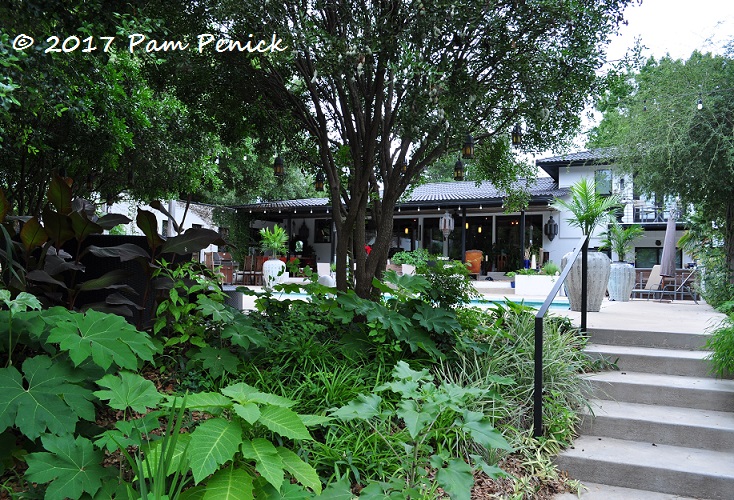
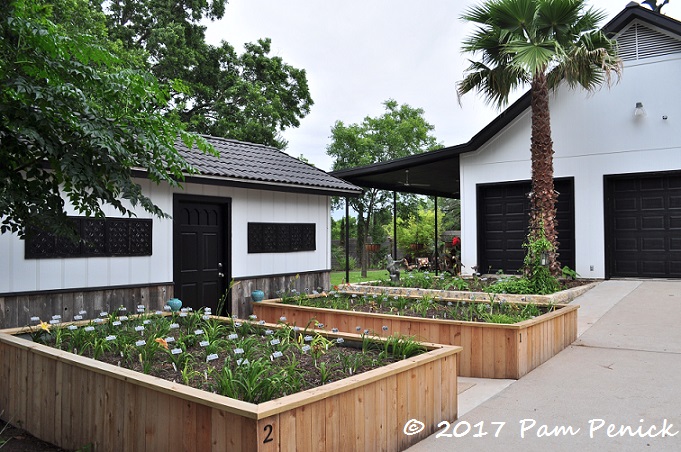
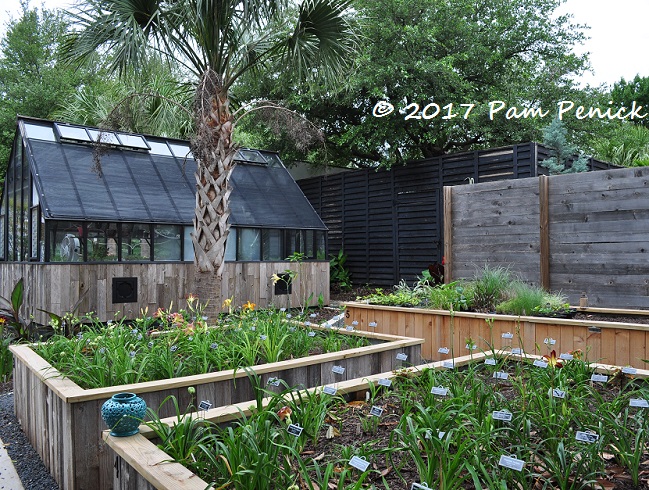
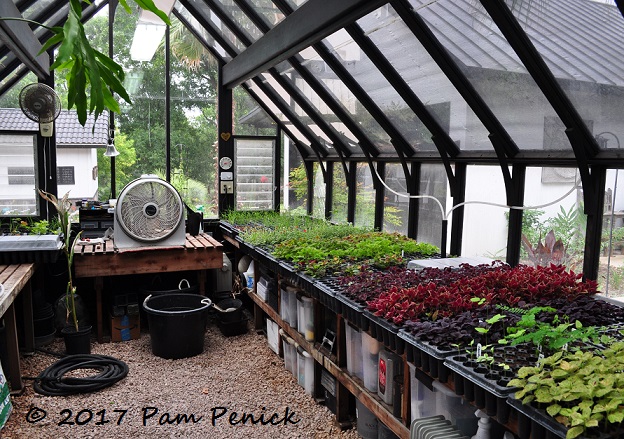
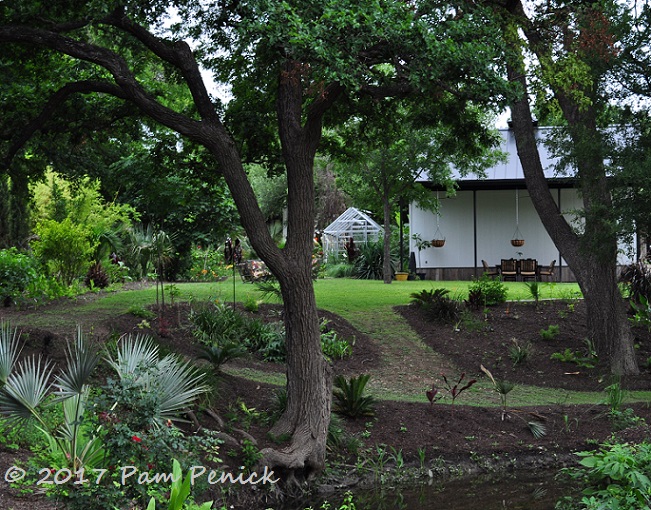
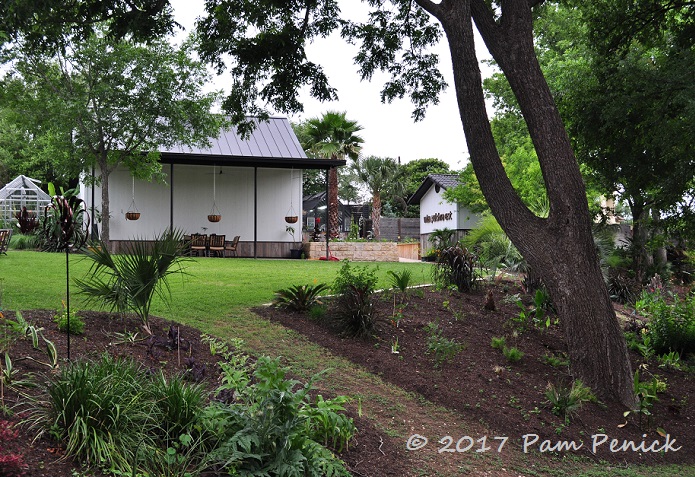
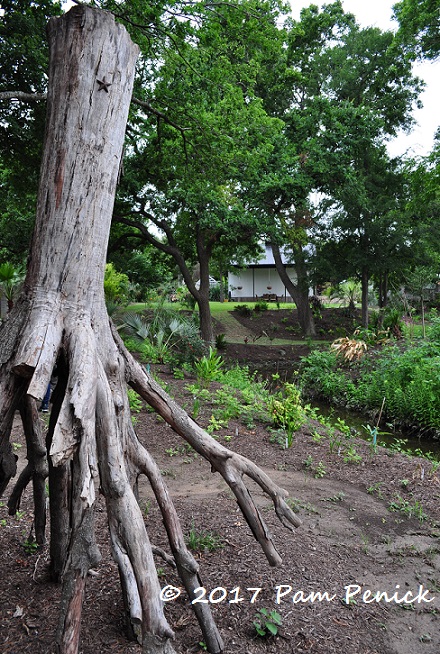
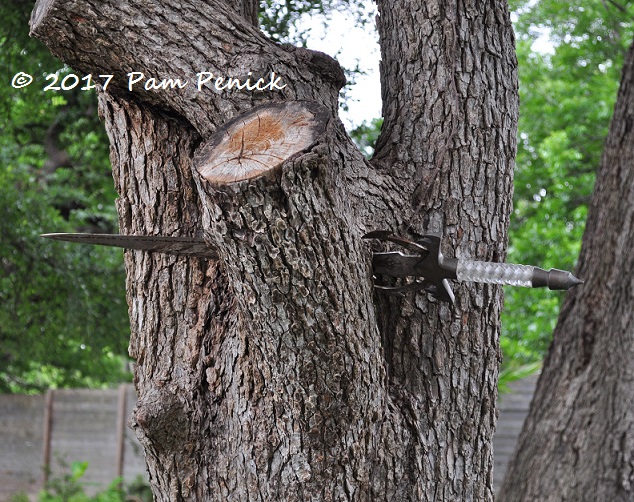
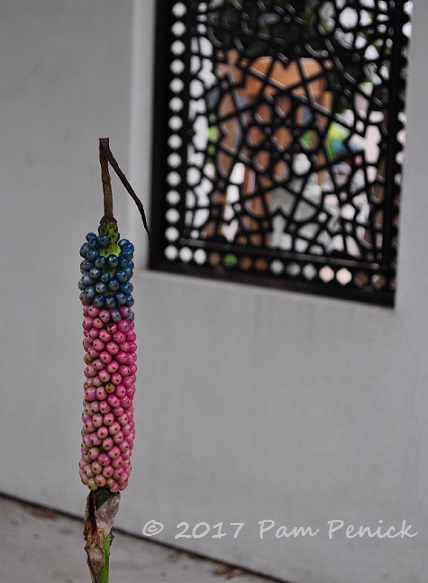
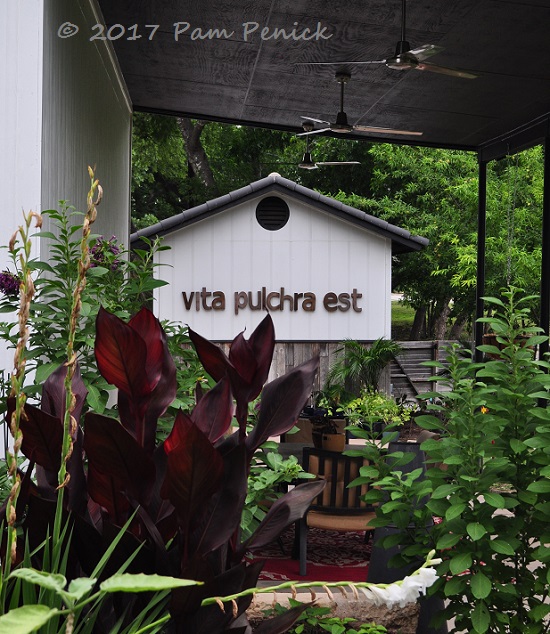
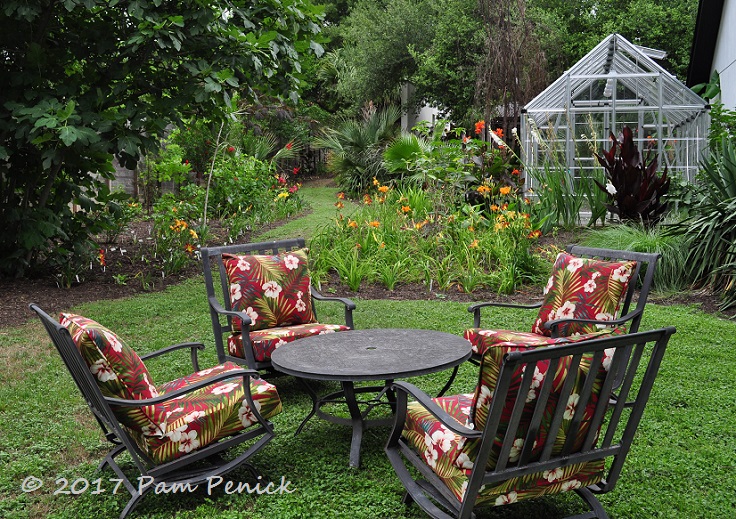
What an interesting place.
It definitely is. —Pam
I love watching their garden transform and evolve. Skottie and Jeff are the best neighbors ever.
Lucky you to have them as neighbors! —Pam
I’m in love with that garden… especially those massive Sophora secundifloras. I didn’t even know they attained such proportions. Thanks for bringing this garden to us.
They can get pretty big, but can you imagine the blooms on these in the spring? It must smell like heaven. —Pam
There seems to be no end to the variety of gardens to be found in Austin and I am sure in all parts of the country. And you manage to find them! Lovely garden full of interesting plants and decor. It felt a little more Indonesian than the Morocco gardens I have seen but still exotic. And the sword in the tree is amazing. I have seen barbed wire and metal signs but that sword is something else.
As you know, I’ve been on the lookout for new gardens this spring, and I was delighted to find this one. You should go visit on Sunday if you have a chance. It’s very different from most Austin gardens I’ve seen. —Pam
That’s a real interesting garden. I can see the Pacific Northwest influences with the black gravel and fence. I wonder if the black makes it feel hotter? Anyway, what I like about that garden is that it’s quite different from most Austin gardens in its plant choices. And that sword, wow!
The black fence is in the Moon Garden, so it’s meant to be seen in the cooler evening hours. But I have dark stain on my lattice fence, and I find it to be a cooling color, like gray, at least in the shade. And yes, this is a different style of garden for Austin! —Pam
Oh, that was a yummy garden! I really like it. Very different. Glad they moved to Austin. You meet the best gardeners!
I feel very lucky to meet so many interesting gardeners! —Pam
I can see this garden in so many geographical locations, including my own , with a slight reset of the plant palette.Really appealing ! And what a paradigm shift moving from the PNW to Austin- they’ve acclimated admirably.
It must be a huge change indeed, coming from such a congenial gardening climate to Central Texas’s more challenging conditions. —Pam
A most unusual garden for Austin! Every thing seems so well designed, even the surprises like the sword. It was wonderful that you found it!
They have a wonderfully creative design sense, and it really shows in both their house and garden. —Pam
I’m always impressed by gardens that carry a strong theme throughout. If only I was capable of such discipline. During the height of our drought, my husband and I semi-seriously considered a move to the PNW. I love rain but, as a native Californian, I wonder if I really could deal with persistent gray days.
Thanks for showing the Tetrapanax in the shade. I received a seedling from Loree and have been wondering if I should give it a shady or sunny setting when it’s big enough to be planted out.
Here it likes shade and regular water, Kris. —Pam
From a purely design standpoint I’d wish for the Tanglewild gardeners to settle on either Morocco or Thailand (surely Morocco would win out: those doors!)
But from a conceptual p.o.v., the schizophrenia nicely evokes Austin’s weather, with its swings between drylands drought and torrential tropical-esque downpours.
Have known quite a few daylily hybridizers, and suspect that lawn won’t be there in a decade…
We certainly do swing between extremes here in Central Texas. What I’m most interested in is seeing if their garden becomes more of a dry garden over time, especially if/when we go through another years-long drought, or whether they’re able to continue with a lusher, more tropical garden style. The big drought that ended in 2013 influenced every local gardener I know, but Tanglewild wasn’t here then. And they do have lots of water, so they can experiment with a lusher garden aesthetic than most Austin gardeners I know. At any rate, it was a delight to explore their garden and see the Pacific Northwest influences they’ve brought to our region. And like you, I suspect their lawn will be whittled away over time. 🙂 —Pam
“Vita pulchra est” Skottie and Jeff what an amazing, beautiful world you’ve created for yourselves there in Austin. What a healing environment that must be. Well done!
I echo your congrats, Kim. It’s a beautiful garden. —Pam
Pam, thank you for sharing the portrait of this fascinating garden. I loved the use of so many antique doors throughout as well as all of the unique artwork. A uniqued and very inspirational place!
I’m glad you enjoyed the tour, Lynn! —Pam
What a beautiful place to be! We daylily growers are crossroads gardeners indeed. We begin with the water saving ethos and then let Austin’s 30-plus inches of rain work their magic in the flower beds growing plants that originated from far away. As I learned from the geographers and their picture of our beautiful country, when in Austin if you’re facing east you’re part of the wet area and when facing west you’re an arid gardener. North-south-wise, the star of life and death does create some interesting extremes for us to deal with on a regular basis, but in return we get a broad palette of plants to chose from for the fun of horticulture.
Despite the challenges of drought and flood and intense heat, we certainly do garden in an interesting area, as you say, Tom, with the prairie meeting Hill Country meeting Old South meeting northern Mexico. It’s exciting to learn what you can grow here. —Pam